Kenneth L. Gentry Jr.'s Blog, page 95
September 27, 2016
THE NARROW GATE AND THE POSTMILLENNIAL HOPE
 PMT 2016-072 by Kenneth L. Gentry, Jr.
PMT 2016-072 by Kenneth L. Gentry, Jr.
Introduction
I am frequently asked how postmillennialism can stand since Jesus speaks of the narrow gate to salvation. This is certainly a reasonable question, because it is a biblical one.
Inquirers often challenge me: I just can’t imagine this present world becoming a Christian majority at any point, especially in light of Christ’s wide and narrow gates and many being called, but few chosen, etc. I don’t see that at all. Never has the world been a friend of God and I don’t see a future scene like that at all in Scripture.
This is an important question. Let’s consider how we can resolve the theoretical problem.
Complication
This certainly is a popular passage that seems to undermine the postmillennial outlook. These words have long been cited to show the paucity of the number of saved:
Dispensationalist Louis Barbieri writing Dallas Seminary’s Bible Knowledge Commentary (BKC, 2:34) writes: “Even the Lord Jesus acknowledged that few would find the true way, the way that leads to life (i.e., to heaven, in contrast with ruin in hell).”
A. B. Bruce writing in the class Expositor’s Greek Testament (1:132) comments on our passage: “The passage itself contains no clue to the right way except that it is the way of the few.”
In his controversial The Gospel According to Jesus, well-respected dispensationalist pastor John MacArthur (191) stated that there cannot be a billion Christians in the world because “such figures certainly do not square with what Jesus said about many on the broad road and few on the narrow.”
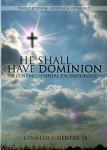
He Shall Have Dominion
(paperback by Kenneth Gentry)
A classic, thorough explanation and defense of postmillennialism (600+ pages). Complete with several chapters answering specific objections.
See more study materials at: www.KennethGentry.com
Reformed amillennialist scholar Herman Hanko agrees: “There are several passages in the scriptures which refer to the fact that the number of the saved, though a great multitude, is nevertheless, relatively speaking small. Texts such as Matthew 7:14 and 22:14 are referred to in this connection. . . . It is like a narrow way, and there are only a few who enter this way.” (Hanko, “An Exegetical Refutation of Postmillennialism,” 15.)
In his highly-regarded Systematic Theology (1124)_premillennialist scholar Wayne Grudem writes of this passage: “Jesus seems here to be saying that those who are saved will be ‘few’ in contrast to the ‘many’ who travel toward eternal destruction.”
Undoubtedly, postmillennialism’s distinctive principle is its conviction that the vast majority of men will be saved. How do we reply to this comment by our Lord himself?
Resolution
We must note that in other places the Bible speaks of the vast number of the redeemed. Interestingly, just a few verses later — and apparently soon after stating the words of Matthew 7:13–14 — the Lord speaks seemingly contradictory words in Mt 8:11: “And I say to you that many [polus, the same word in Mt 7:13 for the lost] will come from east and west, and sit down with Abraham, Isaac, and Jacob in the kingdom of heaven.”
Rev 7:9 speaks boldly of a great number of the redeemed: “After these things I looked, and behold, a great multitude which no one could number, of all nations, tribes, peoples, and tongues, standing before the throne and before the Lamb, clothed with white robes, with palm branches in their hands.” And of course we should recall those prophecies which speak of “all nations” flowing into the kingdom (e.g., Isa 2:2–4; Mic 4:1–4).
Amillennialism v. Postmillennialism Debate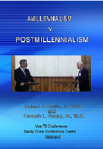
(DVD by Gentry and Gaffin)
Formal, public debate between Dr. Richard Gaffin (Westminster Theological Seminary)
and Kenneth Gentry at the Van Til Conference in Maryland.
See more study materials at: www.KennethGentry.com
Obviously, for the evangelical Christian Scripture holds no contradictions. How, then, can we reconcile such seemingly contradictory passages? And more importantly, how does the postmillennialist deal with Matthew 7:13–14 in light of his optimistic expectations?
To resolve the matter we must realize, two important facts. First, this is a statement about current conditions when Christ speaks. That, in fact, was the situation: very few were coming to the Father in salvation; the vast world was going through the gate of destruction. This is not a prophecy of the future, but a statement of the present situation.
Second, as Warfield noted long ago: “our Lord’s purpose is rather ethical impression than prophetic disclosure.” That is, he is urging his disciples to consider the present situation they witness round about them. They are to look around them and see that many souls are presently perishing and so few men are seeking righteousness and salvation. What will they do about this sad predicament? Do they love him enough to seek its reversal? Christ’s challenge to them is ethical.
In John 4:35 Jesus urges the dim-eyed disciples to see how work must be done: “Do you not say, ‘There are still four months and then comes the harvest’? Behold, I say to you, lift up your eyes and look at the fields, for they are already white for harvest!” In Matthew 7 he warns against false prophets that will arise among the people (Mt 7:15–20). Then he warns that a man must hear and act upon his words (Mt 7:21–27). His disciples must feel the horror of the present vast numbers entering the broad way to destruction.
Certainly the gate to heaven is narrow: Christ is the only way, the only truth, and the only life (Jn 14:6). “There is no other name under heaven that has been given among men, by which we must be saved” (Ac 4:12). For “no man can lay a foundation other than the one which is laid, which is Jesus Christ” (1Co 3:11). But the Lord’s statement in Matthew 7:13–14 does not imply that always and forever he will only save a few people in each era. In fact, Scripture frequently indicates that great multitudes will be saved, that all nations will be discipled, that the world as an organic system will experience the redeeming work of Christ, that all of his enemies will be subdued — to the “ends of the earth.”








September 23, 2016
POSTMILLENNIAL EXPECTATIONS IN CREATION FOUNDATIONS
 PMT 2016-071 by Kenneth L. Gentry, Jr.
PMT 2016-071 by Kenneth L. Gentry, Jr.
Does the “Cultural Mandate” in Gen 1:26-28 help the postmillennial argument? Or is it “forced” evidence? One PMT reader expressed doubt that this has anything to do with the postmillennial hope. So I ask:
Does this passage speak to the postmillennial program? I believe it does. And powerfully so.
My reader noted that the Mandate in Gen 1 was given to Adam “even before there are cultures and sin” and that it was given to “the first `man’ to be the chief or to have dominion over the `lower’ creation, God is simply stating no more nor less than the plan fact that man, as the top of the creation chain made in his image, has been given dominion over the earth and everything in it.” He goes on to argue that this text does “not say it’s `Christian’s’ dominating other man/unbelievers, politics or culture, but Man having dominion over creation. Unless we have an agenda where we want to force the clear plain reading of the scripture to our views.”
I appreciate his interest in sound exegetical arguments, and I understand his confusion on this argument. He apparently has not read postmillennial explanations of this passage beyond brief proof-texts for postmillennialism. Let me explain how this passage is valuable to the postmillennial enterprise.
The Mandate and Man’s Fall
It is true that this Mandate was given prior to man’s Fall into sin and that it involved man’s “rule” over the animal kingdom. However, we must ask: Does it apply even after the Fall? And also: How is that rule over the animal kingdom to come to pass?
I would quickly note that the Mandate does continue after the Fall. We see it re-issued in Gen 9:1-5, with slight alterations. There Noah is re-commanded to be fruitful and multiply, as was Adam. And that “the fear of you and the terror of you will be on every beast of the earth” (Gen 9:1-2). This powerful asserts man’s dominance (rule) over the animal kingdom.
Greatness of the Great Commission (by Ken Gentry)
An insightful analysis of the full implications of the great commission. Impacts postmillennialism as well as the whole Christian worldview.
See more study materials at: www.KennethGentry.com
We see this re-stated again in Psalm 8:5-8: “What is man that You take thought of him, / And the son of man that You care for him? / Yet You have made him a little lower than God, / And You crown him with glory and majesty! / You make him to rule over the works of Your hands; / You have put all things under his feet, / All sheep and oxen, / And also the beasts of the field, / The birds of the heavens and the fish of the sea, / Whatever passes through the paths of the seas.”
Thus, clearly the Cultural Mandate is not withdrawn at the Fall. Man still remains God’s image (Gen 9:6b; 1 Cor 11:7).
The Mandate and Man’s Mission
We also must analyze the Mandate in terms of its contextual setting. We may surmise the culture-wide significance of the Mandate as we consider its original issuance. God was speaking to Adam and Eve as two individuals and one family. He is commanding them to bring all of creation under their authority: “God blessed them [these two people]; and God said to them, `Be fruitful and multiply, and fill the earth [obviously be generating other people through reproduction], and subdue it; and rule over the fish of the sea and over the birds of the sky and over every living thing that moves on the earth [which involves the whole earth].”
Simply put: the rule of the whole earth could not be accomplished by Adam and Eve alone. The task is to big. But the task is not to be pursued by Adam and Eve alone: they are to reproduce and fill the earth, creating great numbers of offspring.
We can see the cultural-building implications of this Mandate reflected in Gen 4. There we find very early man (which Adam is still alive) building human culture: Cain’s son Enoch “built a city [Heb.: yir]” (Gen 4:17). A “city” is an organized settlement of people in a community (e.g., Gen 10:12; 11:4; 18:24; etc.). Such cities require communal operations which develop human culture.
An important part of the advance of human culture involves exercising dominion over the animals. For instance, early man in Adam’s time engaged in sheep herding (Gen 4:2), raising livestock (Gen 4:20) and so forth. As we know, this raising of sheep and livestock will lead to food production, trade, the division of labor, and so forth. So exercising dominion over the animals will be more efficiently done by man working in concert together, i.e., developing human culture.

As It Is Written: The Genesis Account Literal or Literary?
Book by Ken Gentry
Presents the exegetical evidence for Six-day Creation and against the Framework Hypothesis.
See more study materials at: www.KennethGentry.com
In fact, we see that culture-building also in early man’s making tents (Gen 4:20), creating music and making musical instrument (Gen 4:21), and working with “all implements of bronze and iron” (Gen 4:22). All of this requires co-operation: not everyone can mine their own ore, create their own musical instruments, raise all of their own food, and so forth. This requires cooperative effort, which is the very definition of building culture. Indeed, “it is not good that man should be alone” (Gen 2:18), which is implied in the Cultural Mandate requiring that man multiply (Gen 1:26, 28).
In addition, my reader cites Gen 9:1-5. This is not only a re-issue of the Cultural Mandate but necessarily entails social and cultural co-operation. The very text itself warns man of killing men: the warning threatens capital punishment against murderers (Gen 9:6). This results from criminal proceedings operating in a social environment under law.
The Mandate and God’s Goal
The Cultural Mandate did not arise as an aspect of man’s rebellion against God. Indeed, it was issued directly by God at man’s very creation. And though man has fallen and corrupts the Mandate, it still remains as God’s calling. And God intends for man to do it to his glory, which by definition means under Christian influence and principle.
If the Mandate is to be properly and fully engaged, it must be done by true believers in God. It therefore comports beautifully with the postmillennial enterprise.
Click on the following images for more information on these studies:


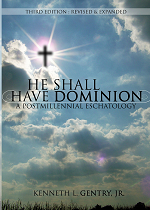








September 20, 2016
DEFINING POSTMILLENNIALISM
 PMT 2016-070 by Kenneth L. Gentry, Jr.
PMT 2016-070 by Kenneth L. Gentry, Jr.
From time-to-time a review is helpful for understanding a system of thought. And basic definitions are therefore in order. This is especially true in presenting postmillennialism because it is widely misunderstood and subject to radical misconceptions. This is a particular problem for attempting to explain postmillennialism to someone who has been a dispensationalist for a long time.
For one to understand any system he must have a proper definition of it. Perhaps more than any of the other evangelical millennial options, postmillennialism has endured much abuse by mis-definition. Indeed, it is the easiest eschatological position to misunderstand in our era and therefore inadvertently to misrepresent. Consequently, we must remind all parties to the debate of this system’s actual claims.
Erroneus Preconceptions
Before I provide a careful, working definition of the system, I would caution non-postmillennialists regarding three faulty assumptions that they must avoid when responding to our eschatological system. And though few competent theologians would intentionally apply these conditions to postmillennialism, I fear that these sometimes lurk unrecognized in the subconscious of too many critics.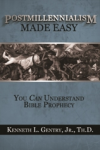
Postmillennialism Made Easy (by Ken Gentry)
Basic introduction to postmillennialism. Presents the essence of the postmillennial argument and answers the leading objections. And all in a succinct, introductory fashion.
See more study materials at: www.KennethGentry.com
First, postmillennialism neither teaches nor implies universalism. Postmillennialism does not claim that at some point in temporal history each and every individual then living will be saved. Even at the very height of the advance of the gospel in history, unbelievers will remain among us, though in a minority status. Some of these will be false converts to the faith, others openly unrepentant resisters to it. Jesus clearly teaches this in his Parable of the Tares among the Wheat (Matt 13:30), just before declaring the enormous victory of the faith in all the world (Matt 13:31-33). This is a part of the “mysteries of the kingdom” (Matt 13:11): the glorious kingdom of God does not overwhelm the world catastrophically (but grows gradually like a mustard plant and penetrates little-by-little as does leaven) and it will not conquer the world absolutely (but grows to a majoritarian dominance like wheat in the field).
Second, postmillennialism neither teaches nor implies perfectionism. Postmillennialists do not argue that at some point in temporal history Christians then living will be perfected. Despite the worldwide victory of the Christian faith, Christians will remain sinners—sanctified sinners, of course, but redeemed vessels of mercy suffering the complications of indwelling sin. Just as no current evangelical church is perfect, neither will an evangelical world be perfect. But if the majority of the human race were conducting themselves as the average church-going, born-again Christian of today, the world would certainly be a different and much better place—despite this lack of perfection.
Third, postmillennialism neither teaches nor implies satisfactionism. Postmillennialists do not argue that Christ’s people should prefer temporal, earthly conquest through gospel dominion over eternal, heavenly victory in consummational glory. Any believer with even a modicum of spiritual sanctification and biblical understanding must recognize the surpassing glory that awaits him in the resurrected estate. Then—and only then—will we see God face-to-face, experience the transformation of our bodies from mortality to immortality, enjoy perfect and permanent freedom from temptation and sin, live forever in blessed circumstances, and be reunited with our saved loved ones. The glory of Christian dominion in the earth pales in comparison to the glory of resurrection majesty in the new earth.
Common Objection
In addition to these three clarifications, postmillennialists endure dissenters reminding us of present sinful world conditions as evidence against our expectations. We must insist that our eschatological system be properly understood: nowhere in the definition of postmillennialism do we declare that by the year 2011 (for instance) we will witness the glorious blessings of worldwide gospel conquest. Until the moment the Lord returns postmillennialism cannot be disproved by evidences from cultural decline and social chaos in the world. Who knows how long God will take to effect the glorious transformation? Just as Christians should not doubt the second coming of Christ because it has not occurred yet (2 Pet 3:4), neither should evangelicals discount the cultural dominion of Christ because it is not full now. All our system requires is that the world be Christianized before the Lord returns—and we do not know when that will be (Matt 24:36; Acts 1:7).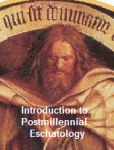
Introduction to Postmillennial Eschatology (10 mp3 lectures)
Southern California Center for Christian Studies seminar.
Lecture presentations and some classroom interaction.
Very helpful definition, presentation, and defense of postmillennialism.
See more study materials at: www.KennethGentry.com
Careful Definition
So then, how should we define postmillennialism? My definition of postmillennialism reads as follows:
Postmillennialism is that eschatological system arising from Scripture that expects the proclaiming of the Spirit-blessed gospel of Jesus Christ to win the vast majority of human beings to salvation in the present age. Increasing gospel success will gradually produce a time in history prior to Christ’s return in which faith, righteousness, peace, and prosperity will prevail in the affairs of people and of nations. After an extensive era of such conditions the Lord will return visibly, bodily, and in great glory, ending history with the general resurrection and the great judgment of all humankind.
Hence, our system is post-millennial in that the Lord’s glorious return will occur after an era of “millennial” conditions. The postmillennialist confidently proclaims in a unique way that history is “His story.

This is only a brief definition, but it is important to have this definition as our starting point. The fullness of the postmillennial system will be fleshed out as we study postmillennialism together on this blog!








September 16, 2016
DOES GOD FORBID ALL IMAGES OF CHRIST?
 PMT 2016-069 by Kenneth L. Gentry, Jr.
PMT 2016-069 by Kenneth L. Gentry, Jr.
On Facebook I recently posted a cartoon exposing the error of Arminianism. Ever since posting that cartoon which contained a (cartoon) representation of Christ, I have been inundated with FB Comments and email challenges.
Some FB friends get frustrated because I don’t engage in FB debates. I don’t do so because they are unending and my day isn’t. I am quite busy. My time on FB looks more ample than it is: I see or think of something that I think is interesting, then quickly go on FB and toss it on my FB page, then leave. Though every now and then I will occasionally reply once or twice.
But for those interested in this particular issue, I will be providing a lengthy article combining my thoughts on defending pictorial representations of Christ. This will be useful in the future when I need to point someone to one source.
My interest in this matter is not because I like pictures of Christ. In fact, I don’t have any hanging in my house, I prefer hanging my wife’s cross-stitched, framed Bible verses in my house. Nor do I think some artist knows what he really looked like. No one does, but neither do they know what Abraham and Paul looked like, though folks accept pictures of them in educational contexts. Nor do I think pictures of Christ are helpful to one’s devotion to him. In fact, I believe quite the opposite: if someone is spiritually encouraged by a picture of Jesus, they are looking in the wrong direction for encouragement. It should come from reading God’s word, not looking at pictures men have painted.
Rather, I engage the debate because I am interested in theologically and exegetically-sound reasoning. And the debate over pictures of Christ expose erroneous exegetical and theological reasoning. What do I mean?
Exegetically, it is impossible to derive a condemnation of pictures of Christ from the Second Commandment (unless, of course, someone reverentially worships them). The Commandment is speaking of worship of images.
Theologically, it is impossible to properly distinguish the two natures of Christ in the arguments presented against pictures of Jesus. And it is impossible to forbid mental representations of Christ (as the Westminster Standards teach) without condemning the apostles who would have remembered what he looked like — and even spoke about it (1 John 1:1–2)!

Covenantal Theonomy
(by Ken Gentry)
A defense of theonomic ethics against a leading Reformed critic. Engages many of the leading objections to theonomy.
See more study materials at: www.KennethGentry.com
This is relevant to postmillennialism in that sound exegetical and theological reasoning push one to postmillennialism. The postmillennial argument does not rest on hopes and wishes, but texts and exegesis.
Thus, here comes my lengthy article on the subject of images of Christ.
I. GOD’S LAW AND PICTURE S OF CHRIST
Reformed Christians have generally been opposed to any artistic representations of Christ. This is due to their reverential concern over breaching God’s Law, particularly the Second Commandment. Unfortunately though, the fear is theologically unbalanced in some respects. Let me present a brief study of the theological and exegetical implications of the Second Commandment.
God and Visible Representations
The Second Commandment reads: “You shall not make for yourself an idol, or any likeness of what is in heaven above or on the earth beneath or in the water under the earth. You shall not worship them or serve them; for I, the Lord your God, am a jealous God, visiting the iniquity of the fathers on the children, on the third and the fourth generations of those who hate Me” (Exo. 20:4-5). Here God expressly prohibits the making of images. But what exactly is being forbidden?
The Amish are fundamentally mistaken when they forbid all visible representations on the basis of their understanding of the Second Commandment. For instance, they forbid the use of mirrors because they reflect their own images. They also forbid art because such creates “images.” However, the Bible does not forbid all images. In Numbers 21:8 Moses is commanded to “make a fiery serpent and set it on a pole.” In Exodus 25:18 the Lord directs Israel to “make two cherubim of gold and place them on the mercy seat in the tabernacle.” So Scripture itself justifies making of images, though not for purposes of adoration and worship (which is the point of the Second Commandment).
The Glory of Christ (book by R. C. Sproul)
From the angels’ revelation of Jesus’ glory to the shepherds outside Bethlehem,
to Jesus’ life-changing revelation of His glory to Paul on the Damascus road, Sproul guides us to a deeper understanding of Christ’s glory.
For more study materials: www.KennethGentry.com
What, then, does the Second Commandment forbid? John Calvin correctly explains in his Institutes (2:8:17) that it prohibits “daring to subject God, who is incomprehensible to our sense perceptions or to represent him by any form,” and that it “forbids us to worship any images in the name of religion.”
But why does God forbid making images of him? Calvin continues: “Visible forms are diametrically opposed to his nature. Every figurative representation of God contradicts his being.” God is invisible (Col. 1:15; 1 Tim. 1:17), non-localized (i.e., omnipresent, Jer. 23:24), and glorious beyond description. Consequently, we read in Deuteronomy 4:12 that “the Lord spoke to you out of the midst of the fire. You heard the sound of the words but saw no form.” Even in heaven the seraphim cover their faces from the majesty of God (Isa. 6:2).
Therefore we read in Deuteronomy 4:15-19: “So watch yourselves carefully, since you did not see any form on the day the Lord spoke to you at Horeb from the midst of the fire, lest you act corruptly and make a graven image for yourselves in the form of any figure, the likeness of male or female, the likeness of any animal that is on the earth, the likeness of any winged bird that flies in the sky, the likeness of anything that creeps on the ground, the likeness of any fish that is in the water below the earth. And beware, lest you lift up your eyes to heaven and see the sun and the moon and the stars, all the host of heaven, and be drawn away and worship them and serve them, those which the Lord your God has allotted to all the peoples under the whole heaven.”
Calvin is surely correct when he notes that “every statue man erects or every image he paints to represent God simply displeases God as something dishonorable to his majesty.” Clearly, then, we must not produce pictures of God or use images as tools for worship.
Christ and Visible Representations
Despite the divine condemnation of making images of God, we are making a theological mistake if we claim that we may not under any circumstance paint a picture of Christ. How is this so, since Christ is God the Son, the incarnation of God (Col. 2:9; Heb. 1:3)?
Simply put, pictures of Christ are not pictures of God. This argument needs to be carefully understood because ultimately the very integrity of orthodox Christianity is at stake.
In A.D. 451 the Fourth Ecumenical Council of the Church meeting at Chalcedon declared the orthodox, biblical view of Christ a great mystery. For Christ really has two natures, unlike us. And his two natures are contained in one person “without confusion, change, division, separation.” Consequently, Christ has both a divine nature and a human nature – without any mixing or dilution of the one in the other.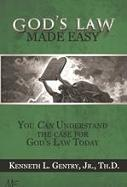
God’s Law Made Easy (by Ken Gentry)
Summary for the case for the continuing relevance of God’s Law.
See more study materials at: www.KennethGentry.com
Thus, a picture of Christ is a picture of his humanity, for he does, in fact, possess a truly human body (as well as a truly human soul). A picture of Christ is not a picture of his inner, divine essence, nor even of his soul. Rather it is a picture of his external bodily form. Thus, a picture of Christ’s human form is a picture of his humanity, not his deity; it is a picture of man (the God-man), not a picture of God.
Some will object that you cannot separate the human and divine, for they are forever united in one person in Christ. It is true that you cannot separate them, but you can distinguish them. In fact, the orthodox view of Christ demands that the two natures be distinguished, for they are without mixture or dilution.
We must remember that the whole point of the incarnation is because the eternal God could not die for the sins of his elect people in order to provide redemption (Heb. 2:9-15). Consequently, the Second Person of the Trinity took upon himself a true human body and soul to accomplish redemption:
• Galatians 4:4-5: “But when the fulness of the time came, God sent forth His Son, born of a woman, born under the Law, in order that He might redeem those who were under the Law, that we might receive the adoption as sons.”
• Hebrews 10:5: “Therefore, when He comes into the world, He says, `Sacrifice and offering Thou hast not desired, but a body Thou hast prepared for Me.”
Thus, when we produce artistic representations of Christ, we ourselves are not making images of God, who is invisible and impossible of representation. Rather, God himself prepared this “image,” the body of Christ. Our picturing Christ’s human form is not our attempt at reducing the divine nature to an image. And the body that Christ took was truly human: it was a body susceptible to thirst (John 4:7; 19:28), weariness (Matt. 8:24), hunger (Matt. 21:18), and death (Rom. 5:6).
We must be careful that we not suggest that his body was divine. When he trimmed his hair, deity did not lay upon the ground to waste away. When his body laid in the tomb in the coldness of death, deity was not dead. Rather, Christ’s mortal body was the real and tangible manifestation of his true incarnate condition. And as such, was capable of artistic reproduction.
We must remember the biblical rationale forbidding Israel from making an image of God: “Then the Lord spoke to you from the midst of the fire; you heard the sound of words, but you saw no form- only a voice.. So watch yourselves carefully, since you did not see any form on the day the Lord spoke to you at Horeb from the midst of the fire, lest you act corruptly and make a graven image for yourselves in the form of any figure” (Deut. 4:12, 15-16).
John 1:18 informs us that “no man has seen God at any time.” Yet many men saw Christ. John also informs us in that very context that “the Word became flesh and dwelt among us, and we beheld his glory” (John 1:14). In fact, when he walked the earth no one could tell by his appearance that in him dwelled the divine nature (except perhaps at the transfiguration, Matt. 17:1-2). As John explains this elsewhere: “What was from the beginning, what we have heard, what we have seen with our eyes, what we beheld and our hands handled, concerning the Word of Life” (1 John 1:1).
When we partake the Lord’s Supper, we partake tangible elements representing the Lord’s corporeal human body. And Christ himself gave us this “image” of him.
We must wonder: If photography had existed in the first century, would God forbid pictures of Christ? Undoubtedly not, for he did not forbid people looking upon him. And surely the disciples themselves (especially) would fondly remember him in his earthly appearance.
II. CATECHISM AND ART
I will briefly consider the Westminster Larger Catechism specifically, then the general question of whether Christian artist should portray the life of Christ in their art.
Visible Representations and Our Catechism
Our Westminster Standards’ Larger Catechism answer to Question 109 states: “The sins forbidden in the second commandment are . . . the making any representation of God, of all or of any of the three persons, either inwardly in our mind, or outwardly in any kind of image or likeness of any creature whatsoever; all worshiping of it, or God in it or by it..”
This Catechetical answer is theologically accurate, I believe. I know beyond any shadow of doubt that the Westminster divines intended to prohibit pictures of Christ. My point is that their statement says one thing but can be read in a perfectly legitimate way to affirm another. In other words, I am simply saying that I can affirm the Westminster Standards while holding to the legitimacy of pictures of Christ.
The Catechism forbids “any representation of God.” But we must remember that according to historic, evangelical, Bible-believing orthodoxy, Christ possessed a true human body and that the divine is not co-mingled in the human. Thus, a picture of Christ is a picture of his human form, not of his hidden, inner deity. At the Transfiguration Christ allowed his inner divine nature to shine through, but otherwise it remained veiled from human eyes.
If we interpret this Catechism answer to mean that no images of Christ’s body may be made (which they intended), then the Catechism would condemn the Apostles themselves. Note that the Catechism not only forbids “any representation of God” but also projecting images “inwardly in our mind.” Consequently, when the disciples would remember (in their minds) the human form of Christ, they would be guilty of breaching the Second Commandment.
Lord of the Saved
(by Ken Gentry)
A critique of easy believism and affirmation of Lordship salvation. Shows the necessity of true, repentant faith to salvation.
See more study materials at: www.KennethGentry.com
Furthermore, you yourselves would be guilty of idolatry from time to time. For how can a minister preach on the cruel crucifixion of Christ and your mind not form a mental image of what he must have looked like hanging on the cross. Yet you would be doing nothing more than mentally conceiving what first century witnesses to the crucifixion actually saw with their own eyes.
The Christian Faith Encourages Art
While dealing with the Second Commandment, John Calvin writes (Institutes 1:11:12): “Yet I am not gripped by the superstition of thinking absolutely no images are permissible. Only those things are to be sculpted or painted which the eyes are capable of seeing: let not God’s majesty which is far above the perception of the eye be debased through unseemly representations.”
I believe a great, though subtle, danger lurks in this widespread Reformed misconception. What are children led to believe when they never see a picture of Christ? They are shown pictures of Abraham, Isaac, and Jacob in their Sunday school literature. They see pictures of the disciples. But every time Jesus should be present with the disciples, he is strangely absent. Are they not being inadvertently taught that he lacked a real, bodily presence?
And what shall become of the influence of Christianity in the arts? Shall we forbid Christian artists from representing for posterity some of the greatest historical occurrences of all times? Shall we forbid them to portray the nativity? Christ’s baptism? His death and resurrection?
We must remember that God created a real body for Christ. That he really dwelled in history in a mortal body. Obviously we should forbid use of pictures in worship, as objects of veneration (just as we should discourage people from venerating their physical Bibles, as if the physical book is somehow a holy object). But I believe we err when we go beyond the Second Commandment and deny all representations of the Incarnate Christ.
III. PRACTICAL CONCERNS AND PICTURES OF CHRIST
Below I will answer two concerns regarding pictures of Christ.
Images in Worship
I have defended the right of artistic representations of Christ. I have not defended – and in fact, stand against – images of Christ being used in worship. In Deuteronomy 4:15 God expressly warns Israel: “So watch yourselves carefully, since you did not see any form on the day the LORD spoke to you at Horeb from the midst of the fire, so that you do not act corruptly and make a graven image for yourselves in the form of any figure.” This statement directly prohibits the use of images in worship.
Our worship of God is to be direct – that is, to God himself. Whereas in producing an image for the purpose of worship, the image itself becomes an object of veneration and adoration.
Finally, we do not see in Scripture the use of images in the worship of God. We do not see this manner of worship in either of the testaments. We do not see worship through images in either precept or practice. God is the one who directs the manner of our worship – and jealously so. We see this dramatically demonstrated in Leviticus 10:1-3:
“Now Nadab and Abihu, the sons of Aaron, took their respective firepans, and after putting fire in them, placed incense on it and offered strange fire before the LORD, which He had not commanded them. And fire came out from the presence of the LORD and consumed them, and they died before the LORD. hen Moses said to Aaron, `It is what the LORD spoke, saying, “By those who come near Me I will be treated as holy, / And before all the people I will be honored.”‘”
As Jesus teaches in the New Testament: “God is spirit, and those who worship Him must worship in spirit and truth” (Jn 4:24). Here we learn that God must be worshiped according to the dictates of truth, that is, according to the express teaching of Scripture.
Images in Art
Pictures of Christ are not to be used as aids in worship. Yet they may be used in other context for other purposes. For example, they may be used in art in representing great historical events and they may be employed as educational “place holders.”
Artistic representations of Jesus present him operating in the material world in the flow of objective history. God is the source of our creativity and talents. We even call artistic abilities “gifts” and say of one who has such a talent that he is “gifted.” Shall those who are gifted in the visual arts avoid making artistic representations of the greatest events of history? Shall art omit – prohibit! – portraying the birth of Jesus, his death on the cross, his resurrection from the tomb, his ascension to glory? These are among the greatest and most glorious events of history, which is very really “his story.”
IV. WHAT DID CHRIST LOOK LIKE?
Now I will consider two practical issues relative to pictures of Christ.
In the past several articles I have broached the question of visible images of Christ because of the debate that arises over the legitimacy of artistic presentations of Jesus. I am strongly Reformed, strongly committed to the Westminster Standards. In those Standards and among many of my Reformed brethren, we see a strong rejection of any and all visual representations of Christ.
The Absurdity of Such Argumentation
Unfortunately, a side-effect of such a position is to prohibit all artistic representations of some of the most important historical elements of the Christian faith: those involved in the life of Christ. I have been arguing that we may produce pictures of Christ for educational and artistic use, though not for worship aids.
But when an argument is given in defense of visual images of Christ, an emotional reaction often arises, takes over, and desperately seeks some other reasons to reject such artistic expressions. Many will drop the exegetical and theological arguments and go straight for the practical difficulty in visual portrays of Christ: “How can we paint a picture of Christ when we do not know what he looked like?”
But this is really no objection whatsoever, and certainly not a logical one. We may easily subject this argument to a reductio ad absurdum. To ask this question is to undermine all artistic renderings of any person, place, or event that we have not seen with our own eyes. Or for which we have no photographs. Or for which we posses no paintings or statues or stone reliefs created by competent and artistically talented eyewitnesses.
Nourishment from the Word
(by Ken Gentry)
Reformed studies covering baptism, creation, creeds, tongues, God’s law, apologetics, and Revelation
See more study materials at: www.KennethGentry.com
On this logic, we should not allow any art representing ancient events unless we have an actual artistic record of the person or event which was created by someone who actually saw them. We should not produce pictures of Abraham, King David, or the Apostles. Nor should we have pictures of ancient battles, common people from 100 BC, famous discoveries, or anything else without an objective visual record preserved for us. This argument simply does not make good sense.
The Error of Such Argumentation
It is true, of course, that we do not know exactly what Christ looked like. But we do posses an enormous amount of information regarding his appearance. We know that he was a male, had two arms, two elbows, two hands, two legs, two knees, two feet, two eyes, two ears, a head, a nose, two eyebrows, hair, lips, teeth, tongue, a torso, skeletal frame, skin covering, etc., etc., etc., etc., etc.
We also know that all of this was organized in the form of what we daily experience as a man. These bodily elements were not a haphazard heap of anatomical parts such as those left over after a Muslim worship service in the Middle East today. Therefore, we do know that he looked very much different than and could easily be distinguished from blades of grass, molecules of iron, continents, barbed wire, bookends, rivers, lemmings, ham sandwiches, Glade air-fresheners, dried paint, computer keyboards (and other parts associated with a computer system), mathematical formulas, the aurora borealis, the alphabet, Roman numerals, comet nebula, atomic explosions, tsunamis, Egypt, and so forth.
That is, we know that he looked like a man. In fact, we know that he looked unremarkable — like an average, ordinary man. The biblical record does not indicate any surprise or confusion at Jesus’ appearance by people interacting with him (except in the case of his temporary transfiguration). People engaged him as if he were another ordinary man like themselves. They did not even know he was the Son of God made flesh — unless he taught them so and they believed it. And even then, his outward visual appearance remained the same.
Thus, in the big picture (no pun intended) we do know what he looked like. Even though we do not know exactly what he looked like. That is, we do know he was “in the likeness of men” and “found in appearance as a man” (Phil 2:7, 8). And this is the point of artistic portrayals of Christ. No artist outside of the most extreme mystic or charismatic visionary argues that he is painting a picture of exactly what Jesus looked like.
The Desperation of Such Argumentation
Some have argued that after he was resurrected, even his own disciples and friends did not recognize him. But this is absolutely irrelevant to the argument. After all, his friends and disciples did recognize him before the resurrection. Does that mean we can paint pre-resurrection pictures of Christ? I am sure the objector does not intend that logical conclusion.
Furthermore, this problem seems to result from some sort of divine intervention which was designed to intentionally confuse them after the resurrection — probably in order to test them. For instance, regarding the Emmaus Road disciples who did not recognize him, we read in Luke 24:31: “Then their eyes were opened and they recognized Him.” This implied that their minds were closed to this prospect until God lifted the mental barrier.
In fact, the opponent of pictures of Christ needs to be careful pressing this argument. After all, historic orthodoxy teaches that Christ arose in the same body in which he died. Thus, he would have looked the same. In fact, his resurrected body even contained the wounds of his crucifixion (John 20:27).
And finally, the people who did not initially recognize the resurrected Christ did finally recognize him. And thus the argument from non-recognition would serve to justify paintings of the now recognized Jesus. The best the argument could do is to declare: we should not have paintings made of the resurrected Christ in the first five minutes of his appearance to different people, but after that, it is okay.
Of course, some artistic portrayals of Christ are more faithful to how he most likely would have appeared: as a ruddy-skinned, dark-haired, middle-Easterner. And if the fair-skinned, light-haired Sallmon’s “Head of Christ” offends for this reason, the offense is only an argument against that sort of representation.









September 13, 2016
ABORTION AND JUSTICE
 PMT 2016-068 by Jonathan Cavett
PMT 2016-068 by Jonathan Cavett
Gentry note: The postmillennial hope anticipates a time in which a biblical society will arise and influence the world. One terrible consequence of the secular humanist society in which we live is its sacrament of death: abortion on demand. This article by Jonathan Cavett speaks powerfully to this issue.
In a biblical society, what are the consequences of an abortion? Guilt? Sorrow? These are the consequences often cited by pro-lifers. On occasion, mothers who have had abortions are even referred to as “victims” – victims of their circumstances, victims of unsupportive boyfriends and husbands, victims of poverty. The list goes on.
But justice is missing from the equation. Where is the blood avenger in all this. Abortion is murder, and there are two manslayers involved in every abortion: the abortionist and the mother of the dead child.
Child Sacrifice Deserves Death
What is the sanction for murder? Because man is made in the image of God, the penalty for murder is the same yesterday, today, and forever: “Whoso sheddeth man’s blood, by man shall his blood be shed: for in the image of God made he man.” (Genesis 9:6)

Political Christianity (book)
(by Christian Citizen)
Christian principles applied to practical political issues, including “lesser-of-evils” voting.
See more study materials at: www.KennethGentry.com
Abortionists and the women who use their “services” are responsible for devouring children made in the image of God, the abortionists for fortune, and the women, many times, for little more than sexual convenience and vanity. Some conservatives permit abortions in situations involving rape and incest or when the mother’s life is in danger, but this is heinous. Abortion is never justifiable – ever. And any mother worth the title would never sacrifice her child to save her own life. Love runs the other direction (John 15:13).
God’s law is unwavering: “Thou shalt not kill.” (Deuteronomy 5:17) “Murder,” as many modern translations have it, puts a finer point on it. Killing isn’t necessarily unlawful, but killing becomes “murder” when someone whom God has not authorized to take life takes a life.
Abortionists and mothers who have abortions are murderers; they are not authorized by God to take life (more on this later). Upon the evidence or two or three witnesses (see Deuteronomy 19:15-21), they must be executed by men authorized by God to do so. This rules out personal vengeance and brings us to the question, “To whom has God given the authority to kill abortionists and women who murder their children?”
Authority to Bear the Sword
In the 1990s, a Reformed Christian and outspoken opponent of abortion named Paul Hill took justice into his own hands, an act which was, biblically, unjust. He shot abortionist John Britton and Britton’s bodyguard to balance the scales of justice. He was lawfully executed September 3, 2003.
But Paul Hill slew a manslayer. Why were his actions unjust? Simply because he had no authority to take Britton’s life. Britton should have been on that table with poison being pumped into his veins instead of Hill, but Hill preferred his own law to God’s law and became guilty of the very crime for which he shot Britton.
Christian Theistic Ethics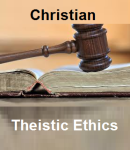
29 Gentry class lectures on mp3 USB
Formal Christ College course on Christian Theistic Ethics. Demonstrates theonomic underpinnings of Christian ethics. Helpful for learning the theonomic system of ethical thought.
See more study materials at: www.KennethGentry.com
So, to whom has God given authority to bear the sword? Only to the civil magistrate. Of the civil magistrate, Paul writes, “For he is the minister of God to thee for good. But if thou do that which is evil, be afraid; for he beareth not the sword in vain: for he is the minister of God, a revenger to execute wrath upon him that doeth evil.” (Romans 13:4)
The civil magistrate is a “minister of God.” Ecclesiastical ministers must be lawfully ordained – and this does not change when “ministers” serve in the civil realm. No biblical Presbytery would allow unordained men into the eldership of a local church. Men must be vested with the covenant authority necessary to the office which they occupy. Elders, deacons, and as we see in Romans 13, even civil rulers, have positions of authority, though their responsibilities and jurisdictions differ. But where does this authority come from? The people?
Biblically, authority doesn’t flow from the bottom up, but from the top down. And by “the top,” I mean the throne of God:
“Let every soul be subject unto the higher powers. For there is no power but of God: the powers that be are ordained of God. Whosoever therefore resisteth the power, resisteth the ordinance of God: and they that resist shall receive to themselves damnation.” (Romans 13:1-2).
Radicals like Paul Hill don’t have the authority to take life, but the civil magistrate does. The men serving in this office are the men God refers to in Genesis 9:6: “by man shall his blood be shed.”
What Can We Do Now?
Christians can do several things in the present to ensure the justice described above is carried out in our grandchildren’s America.
Take Non-Violent Action – In his letter to Paul Hill, Gary North observed that we do not have the right to take lives in this fight against abortion, but we do have the right to have our heads bashed in during non-violent protests. He’s right.
Peaceful protests are one way to fight.
Proclaim the Truth – Take every opportunity you have to proclaim God’s word – all of it. Preach forgiveness through Christ’s substitution for abortionists and murdering mothers who repent and believe, but also proclaim the civil sanctions God places them under.
Preach Law and Gospel – in season and out of season.
Vote – Cast your vote for men who will faithfully fight for biblical legislation. We need Christian Reconstructionists in office who will not only fight to have abortion outlawed, but who will proclaim with unflinching bravery that mothers who have abortions deserve the death penalty as much as the monsters holding the scissors.
If there are no candidates who advocate outlawing all abortions without exception, consider the costs of running for office yourself.
Nullify – At the individual, county, and state levels, it is your obligation before God to uphold his word instead of unjust laws imposed on you by human government. This means you must urge your state to practice civil disobedience and nullify unjust federal laws, no matter how much federal money it costs your state. Counties must do the same for unjust laws imposed by the state, and at the lowest level, you must practice civil disobedience when your county, state, and federal governments impose laws on you that require you to disobey God.
Serve – Be a counselor or financial supporter of faithful, biblically-based pregnancy care centers. These ministries bring you in direct contact with women who are contemplating whether or not they should butcher their babies.
Be Fruitful – Demonstrate how much you value little ones: adopt unwanted children; welcome as many babies into your home as God will give you; and raise your little ones to love the Lord. The wicked are cutting off the next generation of blasphemers every day at their abortion mills. The Church must increase in number, not diminish like the reprobate.
Conclusion
As you denounce abortion, do so with the full authority of Scripture. Don’t trivialize the slaughter by appealing to the guilt and sadness mothers will experience when they must carry on without their children. Tell them they deserve the sword if they kill their child.
There is no neutrality. Whether you enlist in the fight in one of the capacities listed above or in some other way, you don’t have the option to sit this one out. Fight.

Jonathan Cavett is a writer and instructional designer at an alternative finance company. He is co-founder of TheCovenantHerald.com and their newsletter, The Covenant Quarterly.
Click on the following images for more information on these studies:


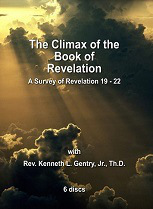








September 9, 2016
STRENGTHENED WITH ALL MIGHT
 PMT 2016-067 a devotional by Don Strickland
PMT 2016-067 a devotional by Don Strickland
Colossians 1:11
“Strengthened with all might, according to his glorious power, unto all patience and longsuffering with joyfulness.”
As we see in verse 11, this verse springs in anticipation of doubt arising from the previous verse. Verse 10 refers to believers “walking worthy of the Lord”. The doubt that Paul anticipates is whether anyone can live in a worthy manner before the Lord. Verse 11 continues to answer the question, “How shall we fulfill that duty?” Paul begins to answer that question at the end of verse 10 by telling the readers they are to be fruitful. Paul adds at the beginning of verse 11 that we will also be “strengthened with all might”, and it was that clause that we studied in our last visit in Colossians. With this Anchor, we look at the efficient cause, or beginning, of that strength – “His glorious power”.
Lord of the Saved
(by Ken Gentry)
A critique of easy believism and affirmation of Lordship salvation. Shows the necessity of true, repentant faith to salvation.
See more study materials at: www.KennethGentry.com
Since those who are already believers are being addressed in these verses, we are to understand that the power of God not only works on a person’s will at conversion, but also continues that work afterward in sanctification. And these words show a surety of action. God will strengthen His people “according to His glorious power”. Our faith is not focused within us or on any object but God Himself, and God’s promise of Christ’s power to save through His death. But Christ’s power is not a part of faith itself. Therefore, faith has no strength in itself. It is kept from failing by the power of God through Christ (1Pt 1.5). Our faith is always being supported, strengthened, and guarded by the power of God. Thus, true faith will not ultimately fail for our hope is a sure and steadfast anchor (Heb 6.19).
It follows then that our strength by which we stand in affliction is also not of ourselves, but from the actual power of God. Thus Paul says that he may be content in every circumstance by God’s power (Phil 4.12-13). As Ezekiel was sent to give a message to a people whose hearts were greatly hardened, God promised to give him strength to equal their hardness of heart (Ezk 3.8-9). God will not fail us. He will supply the strength we need for those works He has planned for us (Eph 4.10).
Further, since the strength to live by faith does not arise from within ourselves, the error of all who claim some goodness or perfection inherent within man (Roman Catholicism, New Age, etc.) is refuted. To say otherwise, would mean we are stronger than Adam in the time of his innocence (ie before his Fall into sin).
Bringing Heaven Down to Earth
(by Nathan Bierma)
A Reformed study of heaven. By taking a new look at the biblical picture of heaven, Nathan Bierma shows readers how heaven can be a relevant, meaningful, inspiring engine of Christian faith and kingdom service.
See more study materials at: www.KennethGentry.com
So if our strength is from the Lord, let us learn to follow the exhortation “be strong in the Lord, and in the strength of His might” (Eph 6.10). But how are we to do this? The Holy Spirit shows us that by the faith of weakness you are made strong (Heb 11.34). By one’s faith will power be drawn from Him. Remember Stephen, who being assured of God’s presence by directing his gaze into heaven, was strengthened to face his persecutors (Acts 7.55).
Keep your eyes of faith upon Him, the Lover of your soul, through whose promises we receive comfort, rest, and peace, whom you have witnessed working on your behalf in the past, and who will glorify Himself through your life. Rest on your faith.

Don Strickland
Don Strickland is a Presbyterian ruling elder. He holds a Th.M. and has done Ph.D. work in church history at Westminster Theological Seminary.
Click on the following images for more information on these studies:


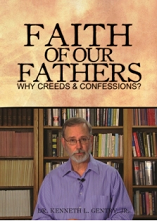








September 6, 2016
TWO KINGDOMS?
P MT 2016-066 a devotional by Don Strickland
MT 2016-066 a devotional by Don Strickland
Isaiah 1:17 Learn to do good; Seek justice, Reprove the ruthless; Defend the orphan, Plead for the widow.
I saw her wandering up the sidewalk in front of the Christian bookstore where I worked in Dallas, TX. I saw her almost every day along that busy road. She couldn’t have been more than 15 or 16 years-old – an otherwise pretty blonde, dressed in the manner of a prostitute, with that vacant, expressionless slack-jawed look of a drug addict. On this day, I was ironically standing near the front at the Bible counter. I watched her approach, and wondered, as I had on several occasions, how I might help her. As she passed the entrance to the store, a pimped-up Cadillac, complete with curb-feelers, parked in front of me at the glass storefront, less than five feet from where I stood. The driver rolled down the passenger side electric window. The girl walked over and leaned into the opening. They spoke for a few seconds. She casually got into the car. And they left. I not only witnessed the entire transaction, they could fully see me standing there as well – surrounded by Bibles.
There are some influential pastors and teachers in the Reformed church who take a new theological position they call “Two Kingdoms” theology (some of their opponents call it “Radical Two Kingdoms” or R2K). This position limits the authority and scope of Scripture to within the Church and thus biblical standards may not be imposed on those who are outside of the Church.
Wall of Misconception: Separation of Church and State
(by Peter Lillback)
Examines our nation’s historic understanding of and the founding fathers
intention in the relationship of our Constitution to matters of faith, ethics, and morals,
taking into account the historical and biblical context as well as
the concept s relation to today’s culture.
See more study materials at: www.KennethGentry.com
One’s theology always has practical consequences. In an R2K controlled world, individual Christians are certainly obligated to present the Gospel to others, but apart of the presentation of the Gospel, the Church itself should separate itself and the application of Scripture from the culture and the state. Because the state is composed of both unbelievers and believers – those living inside and outside of God’s Kingdom, God’s Word holds no moral authority over the state.
So what about the man in the Cadillac and the poor young girl I saw that day at the store? What this teaching means in the real world is that Christians may allow for any sort of perversity to be legal within their culture. The state and the Church are completely separate when it comes to arguing for and legislating morality. Thus, for some in this R2K camp, one may legitimately argue against homosexual “marriage” in the Church, but, at the same time, argue to allow civil laws permitting it. Thus, the Church has no authority to interfere with other’s self-destructive paths so long as they remain outside its walls. The Church’s responsibility to affect people’s lives and the culture around us only begins when someone enters its gates.
Politically, this position appears to be essentially libertarianism. Religiously, it appears to be an exclusion of the Church from the public square – a type of cultural antinomianism. It is as if we Christians are enclosed in our own cultural sanctuary. And we, being on the other side of the glass and surrounded by God’s Word (as I was that day at the Dallas bookstore), deny the physical protection that implementing God’s Law would provide, particularly to the vulnerable. All the while the culture moves forward all around us to openly embrace Hell.
Political Christianity (book)
(by Christian Citizen)
Christian principles applied to practical political issues, including “lesser-of-evils” voting.
See more study materials at: www.KennethGentry.com
Is biblical morality given solely for the Church and its members? As the Book of Deuteronomy shows, the Ten Commandments have a clear corporate application in the ordering of a nation’s laws (eg. Dt 4.7-8). Consider the verse above. “Learn to do good” is the overall controlling command. The next four following commands give us the application of what it means to do good. All four are general commands without the qualification of a “believers only” context. In fact, the verse is part of a passage in which God is pleading for the nation of Judah to repent or experience judgment. Thus, all of the commands assume a mechanism (ie an official civil entity) to bring justice to that situation, because each controlling imperative verb (seek, rebuke, defend, and plead) contains the idea of judgment or justice. For how does one “seek justice” without a judge with the authority to grant it? Upon what grounds does one “rebuke (meaning “judge”) the ruthless”? And from whom and how does one “defend the orphan” or to whom does one “plead for the widow”- both having the idea to gaining a favorable judgement for them? (See also Dt 25.1 and Rm 13.3-4)
Just as it not surprising for a young boy to try to argue with his Christian mom that he is not bound to obedience to the Ten Commandments because he is not a Christian (true story), so too will the unbeliever, individually and corporately, try to deny his responsibility and guilt before God to His commands. But though the unbeliever or the boy are not members of a church, they are creatures of the Creator – created with an immortal soul and implanted with the Creator’s rules for living (the Ten Commandments). Man’s rebellion against God means that his moral compass and understanding of those rules has been twisted and marred, but as the Apostle Paul explains in the book of Romans, God still holds man responsible to maintain His commands and man innately knows he is guilty for not doing so.
The gates of Hell shall not prevail against the Church. And the way the Church achieves that goal can only ultimately be done if it is on the offensive. Yes, that means the conversion of souls. But it also means changing the culture by the Church pressing the claims of Christ and the Law of God upon society at large. Unlike the teachings of multiculturalism, cultures are not created equal. Any culture not founded upon the truth of Christianity is inherently evil at its base.
Western Civilization became one of the few cultures of the world to be captured and molded by a Christian worldview. That statement is not to say that it has ever been perfect. However, there was a common understanding, whether Protestant or Catholic, that the Church possessed the biggest influence within the culture for any refinement or change.
But not so now. The West has been traveling down the path of rejecting her spiritual heritage for some time. Our culture is now not just leaning into the car’s open window. She is in the car and they are driving off. We, as Christians and as the Church, must look to see how we may be complete witnesses to individuals and more broadly to our culture, and then take action. Our time to do so freely may be quickly coming to an end.









September 2, 2016
CHRISTIANITY AND CULTURE
 PMT 2016-065 by John M. Frame
PMT 2016-065 by John M. Frame
Gentry note: God created man as a culture-building creature. The Bible frames in a Christian worldview that is designed to mold culture. Postmillennialists believe in the ultimate success of this culture-molding call. Therefore, we would do well to study the Christian influence on culture. Frame gives several helpful lectures on this whole question. This is his first one: “What Is Culture.”
My general topic is “Christianity and Culture.” I have five sessions with you. In the first, this morning, I’ll ask, “What is Culture?” Tomorrow we will discuss “Christ and Culture,” asking how the Bible describes the relation of Christ to all the cultures of the world. In the third lecture, “Christ and our Culture,” I will get more specific, applying what we’ve learned to the culture we live in, that of the present-day Western world. The fourth lecture, “Christians in our Culture” will discuss ourselves: how should we respond? How should Christians relate to present-day culture: do we flee, fight, set up an alternative, or what? The last lecture, “Culture in the Church,” will discuss what use the church can make of culture in its ministry: in its evangelism, its nurture of believers, and its worship.
So today, we begin by asking, “What is Culture?” Scripture does not contain a definition of culture. Indeed it does not contain definitions of any English words. So we have to understand how the English word is typically used among us, and then ask if that concept matches anything in the Bible, and what the Bible says about it. So we need to start with the use of the term culture in the English language. Etymologically, it comes from the Latin verb colere, which refers literally to agriculture, tilling the ground in order to grow things. By a slight extension, it applies also to growing or raising things that don’t begin in the ground. So equiculture is the growing of horses, aviculture the growing of birds.
Beyond these more literal uses, we use the term culture to describe anything that human beings work to achieve. So culture is not only what we grow, but also what we make, both with our hands and with our minds. It includes our houses, our barns, our tools, our cities and towns, our arts and crafts. It also includes the systems of ideas that we build up: science, philosophy, economics, politics, theology, history, and the means of teaching them, education: schools, universities, seminaries. Indeed, it includes all our corporate bodies and institutions: families, churches, governments. And culture also includes our customs, our games, sports, entertainment, music, literature, cuisine.
So definitions of culture tend to be fairly comprehensive. The Lausanne Committee on World Evangelism defined culture as “an integrated system of beliefs, values, customs, and institutions which binds a society together and gives it a sense of identity, dignity, security, and continuity.” Ken Myers, in All God’s Children and Blue Suede Shoes, writes that culture is “a dynamic pattern, an ever-changing matrix of objects, artifacts, sounds, institutions, philosophies, fashions, enthusiasms, myths, prejudices, relationships, attitudes, tastes, rituals, habits, colors and loves, all embodied in individual people, in groups and collectives and associations of people (many of whom do not know they are associated), in books, in buildings, in the use of time and space, in wars, in jokes, and in food.”
From definitions and descriptions of this sort, you might come away thinking that culture is everything. But that would be a mistake. We should make an important distinction between creation, which is one thing, and culture, which is something else. Creation is what God makes; culture is what we make. Now of course God is sovereign, so everything we make is also his in one sense. Or, somewhat better: creation is what God makes by himself, and culture is what he makes through us. The sun, moon and stars are not culture. The light and darkness are not culture. The basic chemistry of the earth, and the original genetic structure of life forms are not culture; they are God’s creation.
So our discussion leads us, of course, back to Genesis. Although we get our basic definition of culture from our understanding of the English language, we must as Christians go to Scripture if we are to understand what is most important about culture, namely what God thinks about it. In Genesis, we learn that God made the heavens and the earth and everything in them, including man and woman, in six days, however long those days may have been.
At the end of those six days, culture begins. Scripture doesn’t say that God makes or creates culture. Rather, he commands Adam and Eve to make it. Culture is not a creation, but a command, or, as it is often called, a “mandate.”

Greatness of the Great Commission (by Ken Gentry)
An insightful analysis of the full implications of the great commission. Impacts postmillennialism as well as the whole Christian worldview.
See more study materials at: www.KennethGentry.com
God blessed them and said to them, “Be fruitful and increase in number; fill the earth and subdue it. Rule over the fish of the sea and the birds of the air and over every living creature that moves on the ground,” Gen. 1:28.
I will refer to that command from time to time, as many other Reformed theologians have, as the “Cultural Mandate.” It is very important. The first human experience recorded in Scripture is the experience of hearing this command. This command governs everything Adam and Eve would do thereafter. It defines the very purpose of human life.
There are two elements to it: filling and rule. First, filling: Adam and Eve are to have children, grandchildren, and so on. They are not to stay in Eden. Gen. 2:24 says that a man will leave his father and mother and live with his wife, so there is to be a multiplication of homes, ultimately throughout the world.
As they fill the world, they are to rule it. They are not to be terrified by the natural world, like Dorothy and her friends, who cried about the lions and tigers and bears. Nor are they to be fearful of electrical storms, or earthquakes, or desert heat. Rather, they are to march through the world as kings and queens, taking possession of everything. They are to harness the animals, the heat and cold, the electricity and seismic energy, to serve their own purposes. That means development. Adam and Eve are not to leave the world untouched, as some radical environmentalists would prefer. Rather, they are to use the resources of God’s creation, to bring out the potential of the heavens and the earth, to facilitate their rule under God. They are to turn the creation into a culture, into a home for human society.
Of course, use is one thing, exploitation something else. Adam’s family had to remember that they were made of dust. They were not God; they were finite, not infinite. To live, they needed to eat. So although God gave them the right to rule the earth, in one sense they were subordinate to the earth. They needed the earth for their food and shelter. That’s another difference between creation and culture. God creates the world, but does not depend on the world at all. The world depends entirely on him. But in human life, there is mutual dependence between ourselves and the world. The world depends on us to fill and rule it, but we depend on the world for our very existence.
So, just as God told Adam to “take care” of the Garden (Gen. 2:15), Adam’s family was to “take care” of the earth. God wanted them both to use and to preserve. To use, but not to use up. So God later told Israel to rest the land after six years of cultivation. Man is to rule the earth, but also to serve it. He is to be a servant-king. That is the basis of biblical environmentalism.
So culture is what we make, and it begins right after creation, in response to God’s command. But once we see that, we must expand our definition of culture a bit. Culture is not only a fact, but a value. It is not only something that happens; it is something God desires, something God values.
Why did God give this command to Adam and Eve? Well, for the same reason, ultimately, that he does everything else: for his own glory. God’s glory is that beautiful, intense light that shines out from him when he makes himself visible to human beings. In the beginning, God created us as his “image and glory” (1 Cor. 11:7). So he wanted Adam’s family to spread that glory through the whole world. Adam was not to rule merely for himself, but for God, glorifying God in all he did. So culture is based on a divine command. Adam must develop culture because that is God’s desire. Culture is for God’s sake. So it is subject to God’s commands, God’s desires, God’s norms, God’s values.
So as we go back to look again at the various definitions of culture people have offered, we can see that there is almost always a value element, a normative element. In the Lausanne statement, for example, culture is not only crops, farms, and artifacts, but “an integrated system of beliefs, values, customs, and institutions.” Note especially the term “values.” And Lausanne goes on to say that this system is one “which binds a society together and gives it a sense of identity, dignity, security, and continuity.” My own feeling is that the Lausanne statement supposes more unity than there usually is. You might well ask whether our own culture is an “integrated system.” Is it integrated, or is it a collection of many systems, often battling one another for supremacy? Is there any system of values that “binds our society together and gives it a sense of identity, dignity, security, and continuity?” Perhaps at one time Christianity provided that unity; perhaps at another time, the ideas of the Founding Fathers, such as those of the Declaration of Independence and the US Constitution, provided that sense of unity in the United States.
But surely cultures always involve values. If we no longer have unified values, perhaps the conclusion to draw is that we no longer have a single culture. But culture always includes evaluation, a common understanding, not only of what is, but also of what is good and right. So Matthew Arnold, for example, defines culture as “the pursuit of our total perfection by means of getting to know, on all the matters which most concern us, the best which has been thought and said in the world.” And T. S. Eliot understood culture “simply as that which makes life worth living. And it is what justifies other people and other generations in saying, when they contemplate the remains and the influence of an extinct civilisation, that it was worth while for that civilisation to have existed.”
Are you a “cultured” person? In a descriptive sense, we are all cultured, for no human being exists outside of culture. But in a normative sense, sad to say, not all of us are cultured, or at least not all of us are equally cultured. As my high school buddies used to say, there is a difference between “culture” and “culcha.” To be “culcha’d” is to be refined, educated, to have good taste, to be among the elite. If you are culcha’d, you prefer opera to rock and roll, filet of sole to Whoppers, Van Gogh to Norman Rockwell. It’s sometimes hard to draw the line between a respect for cultural norms and mere snobbery. But the word culture traditionally refers to something that’s good, something that’s better.
The definitions of Arnold, Eliot, and Herridge are perhaps unbalanced on the normative side, to the neglect of the descriptive. A better definition will say that culture is both what human society is and what it ought to be, both real and ideal. Culture is what a society has made of God’s creation, together with its ideals of what it ought to make.
Or maybe we should put the ideal first. People make things, because they already have a plan in view, a purpose, a goal, an ideal. The ideal comes first, then making things. First the norm, then the cultivation, the culture.
So now we can see how culture is related to religion. When we talk values and ideals, we are talking religion. In the broad sense, a person’s religion is what grips his heart most strongly, what motivates him most deeply. It is the value that transcends all other values. So Henry Van Til says that “culture is simply the service of God in our lives; it is religion externalized.” It is interesting that that Latin term colere I mentioned earlier, from which we get the word culture also refers to religious service, and comes into English as cult, cultic, and so on. Culture and cult go together.
If a society worships idols, false gods, that worship will govern the culture of that society. If a society worships the true God, that worship will deeply influence, even pervade its culture. If, like ours, a society is religiously divided, then it will reveal a mixture of religious influences.
Religions are totalitarian, you know. They govern everything. That’s certainly true of biblical Christianity. Scripture says, “whether you eat, or drink, or whatever you do, do it all for the glory of God” (1 Cor. 10:31). Rom. 14:23 says, “everything that does not come from faith is sin.” Col. 3:17, “And whatever you do, whether in word or deed, do it all in the name of the Lord Jesus, giving thanks to God the Father through him.” So everything we do in culture will reflect our faith in some way. The same is true if you’re a Muslim: you will seek to express your Islamic faith in everything you think, say, or do. Same for Buddhists, Hindus, atheists, philosophical skeptics, rationalists, modernists, postmodernists, neo- pagan monists. (For these purposes, I’ll use religion, philosophy, and worldview synonymously.) Every worldview, every philosophy, even if it professes to be nonreligious, has this totalitarian influence on human life, and, followed consistently, will dictate a certain kind of culture. Culture, therefore, is never religiously neutral. Everything in culture expresses and communicates a religious conviction: either faith in the true God, or denial of him.
When we think about cultures, or elements of culture, that deny the true God, we must go beyond Gen. 1 and 2, to Gen. 3. For Scripture teaches that we have fallen into sin and that our cultures reflect that Fall. God’s original purpose is to fill the world with human culture that glorifies him. But today, we see people filling and ruling the earth, to be sure, but in human cultures that often express hatred for the creator.
In the Garden of Eden, Eve, then Adam, had a clear-cut choice: whether to obey Satan or God. Did she really imagine that Satan knew something God didn’t know, or that Satan had a higher level of authority? Or did she imagine that she herself had a higher level of authority than either of them, the “right to choose?” Perhaps these boil down the same thing. For when you claim authority for yourself, autonomy, you are playing Satan’s game. That’s exactly what Satan wants you to believe. Certainly, believing in our own autonomy is very foolish. But Adam accepted that foolishness, and it spread throughout their family.
Sin is when we pretend to be our own boss, when we claim to be the final authority in place of God. In our sinful condition, we claim to be the supreme judges of what is true and what is right. As sinners, we seek our own glory, rather than the glory of God. It’s not that sinners don’t know God. Paul in Rom. 1 tells us that sinners know God very well. But they don’t like the knowledge of God. They suppress it; they exchange it for a lie. Then they think and behave as if God didn’t exist. So Paul emphasizes that God-denying cultures are full of idols and every kind of wickedness. At one point, God destroyed mankind with a flood, showing mercy only to Noah and his family. Gen. 6:5 tells us,
The Lord saw how great man’s wickedness on the earth had become, and that every inclination of the thoughts of his heart was only evil all the time.
But the flood didn’t do away with sin. In Gen. 8:21, after the flood, God says it is still the case that “every inclination of his heart is evil from childhood.”
So we might be led to think that there is nothing good in human culture after the Fall. Certainly the stories of Babel, Sodom, and Gomorrah, don’t give us much hope. But other parts of Scripture point to elements of goodness even in fallen culture. Genesis 4 narrates how Adam and Eve’s first son, Cain, murdered his brother Abel. But later in the chapter, we learn that Cain’s family developed a culture. They built a city. Some descendants lived in tents and raised livestock. Others made musical instruments and metal tools. In Scripture, these are all good things.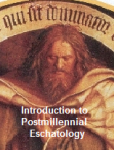
Introduction to Postmillennial Eschatology (10 mp3 lectures)
Southern California Center for Christian Studies seminar.
Lecture presentations and some classroom interaction.
Very helpful definition, presentation, and defense of postmillennialism.
See more study materials at: www.KennethGentry.com
Moses was `educated in all the wisdom of the Egyptians,” according to Stephen in Acts 7:22. Stephen does not condemn this pagan education as evil, but, as Dennis Johnson puts it, “concurs with the Jewish tradition’s positive assessment of Moses’ intellectual engagement with pagan wisdom.” Compare the positive estimate of pagan wisdom in the time of Solomon: Solomon’s wisdom is greater than that of any of the pagan sages (1 Kings 4:29-34), but that assessment assumes that the wisdom of the pagan sages is worth something.
In Samuel, Kings, and Chronicles, we read about Hiram, king of Tyre (called “Huram” in Chronicles). Tyre and Sidon in Scripture are usually examples of wicked cities. But some citizens of these places were expert carpenters and stone masons. David accepted their help in building his palace, and Solomon accepted their help in building the temple of the Lord. 1 Kings 5:6 says that nobody in Israel could fell timber like the Sidonians. Now that’s good. That’s a good skill, and God used it in producing his temple.
Remember, of course, that a person can be skilled and wicked at the same time. You may know a car repairman who’s great at fixing cars, but who overcharges and cheats and lies. Being a good plumber or a good writer or a good pianist doesn’t make you a good person. The word “good” can be confusing here. It can mean ethically good, or merely useful or skilled.
Nevertheless, there are some kinds of goodness even in pagan culture: good products, good skills, real wisdom. The reason is the grace of God. God shows his mercy and kindness to us by bringing us blessings even in wicked cultures. There are two forms of God’s grace that we need to distinguish at this point: common grace and special grace. The basic difference between these is that special grace brings salvation, and common grace does not. But let us look at these a bit more closely.
Common grace, non-saving grace, is a difficult concept to get hold of. The phrase is not biblical; indeed, I don’t know of any passage of Scripture that uses the term “grace” this way. But Scripture does speak of certain blessings of God that fall short of salvation:
(1) God restrains human sin. He keeps people from doing all the wickedness they otherwise would do. So he confused the languages of people at the Tower of Babel, to keep them from accomplishing their wicked purposes (Gen. 11:7). He even keeps Satan on a short leash. God allowed Satan, for instance to harm Job up to a point, but no further (Job 1:12, 2:6).
(2) He gives some blessings to everybody without exception: the rain and sunshine (Matt. 5:43-48, Acts 14:17). He gives food to all living things (Psm. 65:5-13, 145:15-16). He gives civil government “for good” (Rom. 13:4), “so that we may lead a quiet and peaceable life in all goodness and honesty” (1 Tim. 2:1-2).
(3) God gives skills and knowledge to unbelievers, so that they can do good in society. An unbeliever can do no good in the highest sense of good. Paul says that “those controlled by the sinful nature cannot please God,” Rom. 8:8. To please God, our works must be done to the glory of God, obedient to the Word of God, motivated by faith and love of God. Unbelievers never do good works in this sense; indeed, even believers’ works always fall short according to this standard. But unbelievers are able to do things that look good to us. They don’t look good to God, for God knows the heart. But they look good to us, and they often bring benefits to society. So non-Christians often improve society through their skills and ideas. They make scientific discoveries, produce labor-saving inventions, develop businesses that supply jobs, produce works of art and entertainment.
That’s common grace; and you can see how God’s common grace leads to many good things even in unbelieving culture.
The other source of goodness, of course, is God’s special grace, his work of saving the world through Christ. This work of God goes far beyond common grace. For God sent Jesus, not just to keep us from being as bad as we could be, but to make us as good as creatures can be, to transform us into the glorious image of Christ himself. Jesus died for his people and rose again, so that they might be raised with him, dead to sin, alive to righteousness in Jesus. The Gospel calls people of all nations to turn from their sins, believe in Jesus, and receive God’s saving grace, his free gift of eternal life.
Does God’s saving grace make an impact on culture? Certainly it does. When you believe in Jesus, your whole life changes direction: your thoughts, words, and deeds. Whether you eat, or drink, or whatever you do, you seek to do it to God’s glory. So whether you are a car repairman, a homemaker, a poet, a plumber, a pianist, a civil magistrate, or a pastor, you try to do your work to the glory of God. You’ll fail, because you won’t be perfect until glory. But you’ll try. And sometimes trying can make a huge difference. You can influence your culture, as many Christians have.
If you read a book like D. James Kennedy and Jerry Newcombe, What If Jesus Had Never Been Born, you should be impressed at the great influence of the Christian gospel, and specifically Calvinism, upon western culture. I don’t want to minimize the wickedness of modern culture, and both Peter and I will say much about that this week. But for now I’m making the point that there is good as well. Kennedy and Newcombe emphasize that Christians, for distinctively Christian motives, have vastly influenced western culture in such areas as help for the poor, teaching of literacy, education for all, political freedom, economic freedom, science, medicine, the family, the arts, the sanctity of life. Without Jesus, without his Gospel, without the influence of his people, all these areas of culture would be vastly different and very much worse.
The Gospel, you see, is not only a message for individuals, telling them how to avoid God’s wrath. It is also a message about a Kingdom, a society, a new community, a new covenant, a new family, a new nation, a new way of life, and, therefore, a new culture. God calls us to build a city of God, a New Jerusalem.
Major Bible Prophecies (5 mp3 lectures)
Gentry conference lectures on the Millennium, Daniel’s 70 Weeks,
Man of Sin, Heaven, and Unfulfilled Prophecies.
See more study materials at: www.KennethGentry.com
Remember the cultural mandate. Sin does not abrogate it. God repeated it to Noah’s family in Gen. 9:1-7. Nor does Jesus abrogate it. Indeed, he restates it for his church in the Great Commission, Matt. 29:19-20. Theologians have often debated how the Cultural Mandate and the Great Commission fit together. For now, just remember that both of these call for a renewed culture.
Therefore go and make disciples of all nations, baptizing them in the name of the Father and of the Son and of the Holy Spirit, and teaching them to obey everything I have commanded you. And surely I am with you always, to the very end of the age.
You see how comprehensive that is? The Great Commission tells us not only to tell people the Gospel and get them baptized, but also to teach them to obey everything Jesus has commanded us. Everything. The Gospel creates new people, people radically committed to Christ in every area of their lives. People like these will change the world. They will fill and rule the earth to the glory of Jesus. They will plant churches, establish godly families, and will also plant godly hospitals, schools, arts, and sciences. That’s what has happened, by God’s grace. And that is what will continue to happen until Jesus comes.
Does that mean that culture is OK, after all? That we don’t need to worry about it? Certainly not. What it means, is that the relation of Christ and Culture is more complicated than you may have thought. It’s certainly not warfare, pure and simple. There is a war, but the war is between Christ and Satan, Christ and unbelief, not Christ and culture. Nor is it a mutual embrace. Culture is an ambiguity, a mixture, of sin and righteousness, of good and bad, of love of Christ and hatred of Christ. That picture leaves us much to explore in remaining sessions.
Gentry note: Frame’s next lecture is on “Christ and Culture.” His third lecture is: “Christ and Our Culture”; his fourth lecture is: “Christians In Our Culture.”
To continue reading the lectures:
http://www.thirdmill.org/newfiles/joh_frame/Frame.Apologetics2004.ChristandCulture.pdf








August 30, 2016
DID PAUL TRY TO TRANSFORM SOCIETY?
 PMT 2016-064 by Christopher Hume
PMT 2016-064 by Christopher Hume
One of the practical implications of a robustly postmillennial theology is the need to transform our society according to the Word of God. To the great detriment of our nation, the church in America has largely embraced a pessimistic outlook of the future and has therefore abandoned the effort to build a Christian society. An objection from many sincere Christians is that the New Testament “does not focus on political issues.” In fact, the Apostle Paul is often cited as the prime example of one who did not really get involved with political issues. Paul, the reasoning goes, was simply focused on “preaching the gospel” and did not spend time trying to change the culture or society (which includes laws, institutions, etc.). However, my contention is that the Apostle Paul not only tried to change the societal and political landscape, he succeeded!
The Apostle Paul described the essence of his preaching as Jesus Christ and the crucifixion: “And I, brethren, when I came to you, came not with excellency of speech or of wisdom, declaring unto you the testimony of God. For I determined to know nothing among you, save Jesus Christ, and him crucified” (1 Cor. 2:1-2). Using the analogy of faith, we know Paul did not mean by this that he was not interested in other things. Paul clearly taught on sexual ethics, church order, spiritual gifts, elder and deacon qualifications, husband and wife relationships, family and children, government, prayer, eschatology, and much more. In verse one, Paul is contrasting his speech with that of the Greek orators who focused on eloquence and persuasion. Paul did not rely on fancy rhetoric but rather on the truth of God—his preaching was “in demonstration of the Spirit and of power” (1 Cor. 2:4). When Paul said he determined to know nothing but “Jesus Christ, and him crucified” he was referring to the core and substance of all his teaching. Everything he taught (from family to government to eschatology) was rooted in Jesus Christ and his work of redemption. His desire to change the culture (and his success) was also rooted in Christ and the cross.
Political Christianity (book)
(by Christian Citizen)
Christian principles applied to practical political issues, including “lesser-of-evils” voting.
See more study materials at: www.KennethGentry.com
So, did Paul try to change society? In his 1828 dictionary, Noah Webster defines “society” as follows:
The union of a number of rational beings; or a number of persons united, either for a temporary or permanent purpose. Thus the inhabitants of a state or of a city constitute a society having common interests; and hence it is called a community. In a more enlarged sense, the whole race or family of man is a society and called human society. The true and natural foundation of society are the wants and fears of individuals.
Paul taught that “God…commandeth all men every where to repent” (Acts 17:30, emphasis added). Paul sought to bring about the most fundamental change within society: the changed heart of the individual. The Christian faith drastically reorients the “wants and fears” of individuals (cf. Ps 37:4; Prov 29:25; Luke 1:74; Heb 2:15). The changed individual is the foundation for any change that will come about in the society. There is no question that the preaching of the Gospel and its call for obedience radically changes individuals (cf. 1 Cor 6:11).
The next level of society is the family. Paul taught extensively on the family, seeking to change the way people operate in the realm of family government (1 Cor. 5:1, 7:1-9, 11:2-16; Eph 5:21-6:4; Col 3:18-21; 1 Thess 4:3-7; 1 Tim 3:2, 4; Titus 1:6). A third level of society is the church. Clearly, Paul taught in-depth about the church—teaching on elders, deacons, church discipline, the Lord’s Supper, baptism, care for widows in the church, and on and on.
The fourth level of society may be labelled as civil government. This is the one area which many Christians say Paul did not seek to change. However, Paul did teach specifically on the civil government (Rom 13:1-7). He taught that the civil government was ordained by God to “execute wrath upon him that doeth evil” (Rom 13:4). It is undeniable that Paul’s referent for evil is that which is contrary to God’s moral law (cf. 1 Tim 1:8-11). By teaching this, Paul was seeking to change the view that the civil government is not required to govern according to God’s standard of good and evil. Civil rulers in Paul’s day often did not execute wrath on “him that doeth evil,” but rather on the one that did good (Matt 14:1-14; Luke 23:33). Noah Webster defines teaching as communicating “to another the knowledge of that of which he was before ignorant.” Therefore, when Paul teaches on civil government he is seeking to transform the society’s view of it.
It is clear that every level of society was addressed by Paul (not to mention the authors of the Old Testament and the rest of the New Testament). The next objection may be that if Paul was trying to change the society—individual, family, church, and civil government—he failed. Did Paul fail?
The first thing to note is that extensive societal transformation is not the same as total societal transformation. Postmillennialists do not believe that every member of society will be converted in history. Rather, “postmillennialism expects that eventually the vast majority of men living will be saved. Increasing gospel success will gradually produce a time in history prior to Christ’s return in which faith, righteousness, peace, and prosperity will prevail in the affairs of men and of nations” (Gentry). Furthermore, we must not measure Paul’s success solely in terms of the immediate results during his lifetime. When we take the long view, specifically relating to Western civilization, it is undeniable that Paul (through the power of God) was successful in drastically transforming society.
Redeeming Pop Culture
by T. M. Moore
Why is it important for us not to ignore the culture around us? How can we engage, influence, and advance pop culture, and how can we put popular forms to good use in God’s kingdom? Moore urges us neither to flee from popular culture nor to immerse ourselves in it blindly.
See more study materials at: www.KennethGentry.com
For example, the transformation of England from a backwater, corrupt nation into an incredible missionary force for Christianity can be traced to the introduction of the Geneva Bible (and with it, Paul’s teaching).
England of 1557 was a society beset by contradictions, oppression, and even barbarity. More than 300 men had been burned at the stake by the Catholic tyrant, “Bloody Mary” Tudor, merely for promoting the English Reformation. Many clergymen, Catholic and Protestant both, exacerbated rather than soothed the distress; semi-literate as a class, most received their parish jobs as payoffs and often were unwilling to preach, or incapable of composing sermons. The impoverished and spiritually bereft masses found solace elsewhere—sloth, dissipation, or drink—while the gentry sought after wealth, social position, and favors of royal courts. Into this seemingly hopeless culture of corruption and error, the light of God’s written Word—in the newly translated, published, and distributed Geneva Bible—inexorably began to liberate the English-speaking people, penetrating hearts and transforming minds. It is no exaggeration to say that the Geneva Bible was the most significant catalyst of the transformation of England, Scotland, and America from slavish feudalism to the heights of Christian civilization. (Foster, Introduction to the Geneva Bible, Tolle Lege Press, xiii)
Until relatively recently the majority of laws in Western culture were based on Christian principles (even to this day many still are). Australian law professor Augusto Zimmerman, in an article entitled “A Law above the Law: Christian Roots of the English Common Law,” notes: “The English common law has an incredibly rich Christian heritage. England’s most celebrated jurists—including the likes of Blackstone, Coke and Fortescue—often drew heavily from their Christian faith when expounding and developing what are now well established principles and doctrines of the common law” (85). Space would fail me to cite all the ways in which Christianity has transformed Western culture (not to mention the world). Wherever one looks into the history of Western culture, Christianity has had an incredible transformative power. The current heightened attack on Christian values in society demonstrates the roots of our nation (and all of Western culture). The worldviews we see being promoted today (humanism, homosexuality, feminism, abortion, statism, atheism) stand in direct opposition to the rich Christian heritage of Western civilization—a civilization with roots going all the way back to the Apostle Paul (and further).
Paul sought to transform society by teaching a distinctly Christian worldview for the four areas of culture: (1) self, (2) family, (3) church, and (4) civil government. Of course Paul did not know the details of what would take place in the following years. However, it is not anachronistic to say that Paul sought to see nations transformed. After all, his Lord and Savior commanded Christians to “go ye, therefore, and teach all nations” (Matt 28:19). The great Puritan commentator Matthew Henry, in commenting on this verse, gives the rallying cry for Christian missions: “Do your utmost to make the nations Christian nations.”
Not only did Paul try to transform the society, he was actually successful as evidenced by the remarkable transformation of culture that has taken place from the time of Christ until today. Paul was not alone; the transformation drew upon many other laborers. From Athanasius to Augustine to Calvin—not to mention thousands of individuals whose names are lost to history—God has been using Christians to faithfully proclaim the truth and teach all nations to obey. There is more work to be done. However, the argument that Paul did not try to transform the society should be silenced by a careful consideration of the implications of his doctrine and the irrefutably enormous influence of Christianity upon Western culture. Postmillennialists believe that God is able to do even more in the days ahead.

Christopher Hume holds the M.A. degree in Literature from Clarks Summit University and is a seminary student at Baptist Bible Seminary. He lives in Pennsylvania with his wife and four younglings. He is currently seeking to plant a postmillennial church in eastern Pennsylvania. You can reach him at hume227@gmail.com









August 26, 2016
AN INVITATION TO YOU
 PMT 2016-063 by Kenneth L. Gentry, Jr.
PMT 2016-063 by Kenneth L. Gentry, Jr.
Postmillennialism does not arise among Christians as a natural reflex — though it should if they pray the Lord’s Prayer believingly (“Your kingdom come / Your will be done, / On earth as it is heaven,” Matt. 6:10) and understand the Great Commission rightly (“Go therefore and make disciples of all the nations . . . and lo, I am with you always, even to the end of the age” (Matt. 28:19, 20).
Our age is one of simplistic Christianity and social collapse. Neither of these problems is helpful for suggesting postmillennialism as an eschatological option. (But remember: postmillennialism does not hold that by the year 2016 we will see the fullness of Christian influence throughout the world. Until the Lord returns we cannot discount the postmillennial hope on the basis of current world conditions.) The simple Bible-thumping of rampant dispensationalism and the disorientation that comes with social chaos lead many believers to eschatologies of despair.

Greatness of the Great Commission (by Ken Gentry)
An insightful analysis of the full implications of the great commission. Impacts postmillennialism as well as the whole Christian worldview.
See more study materials at: www.KennethGentry.com
The shallowness of modern preaching and the desire for church fun rather than Bible study are hindrances to a hope rooted in Scripture. I know, because I was converted from within a dispensational environment having understood all of Scripture from that confused perspective.
Until . . . . Until I was taught in depth by someone who was strongly committed to Reformed, covenantal, Bible-based postmillennialism: Dr. Greg L. Bahnsen (at Reformed Theological Seminary). When I first entered his class on “History and Eschatology,” my long-ingrained dispensational despair led me to resist his teaching, deeming it absurd. However, he relentlessly expounded the Scriptures in such a way that I set eventually was overwhelmed with the evidence. I set aside my populist theology and committed to the eschatology of hope, postmillennialism.
I am making these opening observations in order to encourage you, my reader, to consider joining with me in promoting the postmillennial faith. Christians are not going to reflexively adopt our worldview. They need a challenging presentation of the deep things of God in order to do so. I write this blog to minister to postmillennialists and to challenge non-postmillennialists. And I would like to invite you to contribute original articles and to send in helpful news links that encourage a postmillennial orientation.
The more of us who are sounding off, the more of us who are producing studies, the better. The modern Christian market is not flooded with postmillennial studies as it is with dispensational superficialities. I want to encourage more postmillennialists to begin publishing materials so that we can reach the broader church. If you submit an article that I can publish, you could then direct your Christian friends to this site to read it. Your testimony might be just what grabs their attention.
He Shall Have Dominion
(paperback by Kenneth Gentry)
A classic, thorough explanation and defense of postmillennialism (600+ pages). Complete with several chapters answering specific objections.
See more study materials at: www.KennethGentry.com
So I am asking my readers to consider producing some studies and submitting them to me for publication (without remuneration, unfortunately). These could be testimonies regarding how you came to adopt postmillennialism. Or they could be key texts that have helped firm up your postmillennialism. Or they could point to books and publications that you believe are important for advancing the postmillennial hope.
In addition, I would welcome any news links that might be encouraging to postmillennialism. For instance, I have published several news items showing how Christianity is growing in Muslim lands, despite the enormous persecution of the church in those area. Sometimes Christians are discouraged by their reading only bad news. Bad news sells. But good news lifts! And we need to uncover those news items that might encourage the faith of Christians.
If you would like to send me some items, I would love to hear from you. If you have never written anything for publication, you might want to take my correspondence course on writing to help you along (see ad below). We do need more Christians writing and exercising an influence by the written word.
You can contact me through this website, or directly at: KennethGentry@cs.com. I hope to hear form you!









Kenneth L. Gentry Jr.'s Blog
- Kenneth L. Gentry Jr.'s profile
- 85 followers



